Elbow Dislocation
An elbow dislocation happens when the bones that make up your elbow joint are forced out of their normal position. The elbow joint is where three bones come together: the upper arm bone called the humerus, and two forearm bones called the radius and ulna. When these bones become separated, it’s called a dislocation.

Elbow dislocations usually occur when there is a strong force applied to the elbow, like falling onto an outstretched arm or during a sports injury. When this happens, the bones that make up the elbow joint can slip out of place, causing pain, swelling, and a limited range of motion in the arm.
An elbow dislocation is an emergency, so it’s important to seek medical help right away. A doctor or healthcare professional will examine your arm and may order an X-ray to confirm the dislocation and check for any associated fractures.
X-ray, dislocated elbow
The treatment for an elbow dislocation involves a process called reduction. This is when the doctor gently moves the bones back into their normal position. You may be given pain medication or even anesthesia to make you more comfortable during this process. Once the elbow is back in place, the doctor will usually apply a splint or cast to keep it immobilized and help it heal properly.
The treatment recommendations for an elbow dislocation may differ however if there are associated fractures.
If you have an elbow dislocation, it is very important that you are seen by an orthopedic specialist soon after your initial treatment. Elbow dislocations with associated fractures may require surgical treatment.
After the initial treatment, you will likely need to undergo a period of rehabilitation. This involves exercises and physical therapy to help regain strength, improve range of motion, and prevent stiffness in the elbow joint. Your healthcare provider will guide you through this process and give you specific exercises to do.
It’s important to follow your doctor’s instructions carefully and attend any follow-up appointments to ensure that your elbow heals properly. With proper treatment and rehabilitation, most people recover well from an elbow dislocation.
However, in some cases, the elbow joint may remain unstable even after reduction. This instability can lead to recurrent dislocations or chronic pain, which may necessitate further evaluation and potential surgical intervention. In such situations, your doctor may recommend additional diagnostic imaging, such as an MRI (Magnetic Resonance Imaging).
 MRI can provide detailed images of the soft tissues, including ligaments, tendons, and cartilage, allowing the doctor to assess the extent of the damage and identify any associated injuries or complications. It helps in determining the specific structures involved and can guide the decision-making process regarding the need for surgery.
MRI can provide detailed images of the soft tissues, including ligaments, tendons, and cartilage, allowing the doctor to assess the extent of the damage and identify any associated injuries or complications. It helps in determining the specific structures involved and can guide the decision-making process regarding the need for surgery.
Surgery for elbow dislocation is usually reserved for cases where the joint remains unstable despite conservative treatment or when there are associated fractures, severe ligament damage, or other complications. The surgical procedure aims to realign the bones, repair damaged ligaments or tendons, and restore stability to the joint. The specific surgical technique employed will depend on the individual case and the surgeon’s expertise.
Elbow ORIF (open reduction internal fixation)
It’s important to note that the decision regarding the need for an MRI or surgery is made by a qualified medical professional based on a thorough evaluation of your specific condition. They will take into account various factors, such as the severity of the dislocation, presence of associated injuries, and the overall health and lifestyle of the patient. Therefore, it’s crucial to consult with your doctor for an accurate diagnosis and appropriate treatment recommendations for your elbow dislocation.
Remember, if you ever experience an injury like an elbow dislocation, it’s always best to seek medical help from a healthcare professional. They can provide the appropriate care and guidance based on your specific situation.
